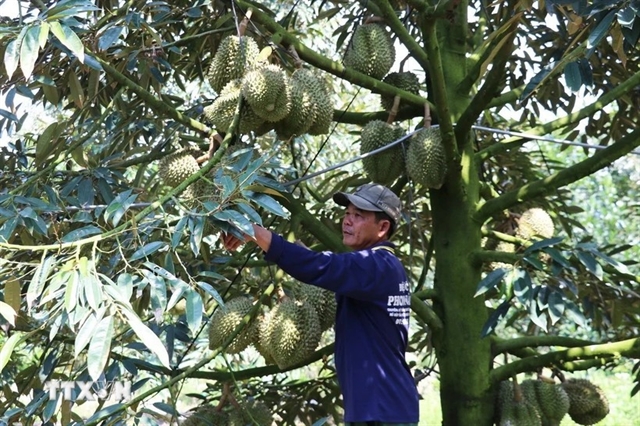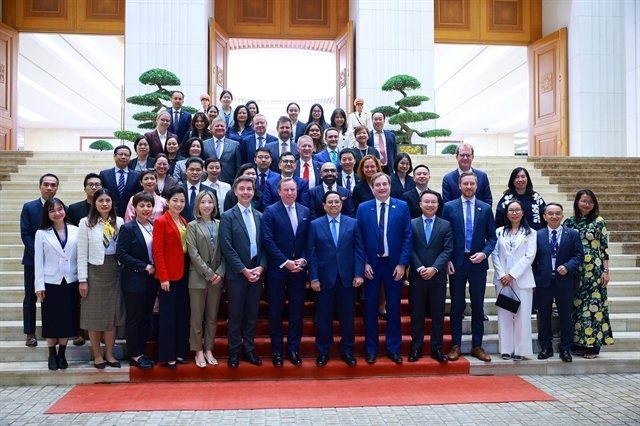 Economy
Economy

 |
| Deputy Minister of Agriculture and Environment Phùng Đức Tiến. VNS Photo |
By the end of the first quarter of 2025, Việt Nam’s agricultural, forestry and fishery exports had reached US$15.72 billion, marking a 13.1 per cent increase compared with the same period in 2024. With this strong start, the ambitious $70 billion export target for the year is well within reach.
Deputy Minister of Agriculture and Environment Phùng Đức Tiến speaks to Việt Nam News reporter Tố Như to discuss this achievement.
How do you evaluate the performance of the agricultural sector and, in particular, agricultural, forestry and fishery exports during the first quarter of 2025?
Since the beginning of the year, Việt Nam’s exports have faced considerable pressure and challenges due to global and regional developments. However, thanks to the leadership of the Government and the Prime Minister, Phạm Minh Chính, as well as the active participation of ministries, local authorities, and businesses, agricultural, forestry, and fishery exports in Q1 2025 achieved impressive results, with total export revenue reaching $15.72 billion - up 13.1 per cent year-on-year.
These strong first-quarter results set a solid foundation for the coming months, bringing us closer to our goal of $70 billion in total exports by the end of 2025.
What factors contributed to this growth?
In the first quarter of 2025, some agricultural exports saw increased volume but lower value, while others experienced growth in both areas.
For instance, coffee exports in the first quarter of 2025 reached 509,500 tonnes, generating $2.88 billion - a 12.9 per cent decline in volume but a 49.5 per cent surge in value compared to the same period in 2024. The average export price of coffee in the first three months of 2025 was estimated at $5,656 per tonne, a 71.7 per cent increase year-on-year. The top three export markets for Vietnamese coffee were Germany (16.2 per cent), Italy (9.9 per cent), and Japan (7.4 per cent).
For rubber, export volume in Q1 2025 was 396,100 tonnes, earning $765.8 million - a 4.4 per cent drop in volume but a 26.1 per cent rise in value compared to Q1 2024. The average export price of rubber increased 31.9 per cent to $1,933.3 per ton. China remained Việt Nam’s largest rubber market, accounting for 73.7 per cent of total exports, followed by India (3.8 per cent) and Indonesia (3.2 per cent).
Aquatic product exports also performed well, generating $2.29 billion in revenue - an 18.1 per cent increase year-on-year. The top three markets for Việt Nam’s seafood exports were China (21.7 per cent), Japan (15.6 per cent), and the US (15.1 per cent).
Wood and wood product exports in Q1 2025 totalled $3.95 billion, marking an 11.6 per cent increase over the same period in 2024. The US remained the largest market for Vietnamese wood products, accounting for 53.1 per cent of total exports, followed by Japan (13.2 per cent) and China (10.6 per cent).
Pepper exports reached 47,300 tonnes, generating $323.6 million - a 16.7 per cent drop in volume but a 37.3% increase in value. The average export price of pepper in Q1 2025 was $6,845.4 per tonne, up 64.9 per cent year-on-year. The top three markets for Vietnamese pepper were the US (24.4 per cent), Germany (10.4 per cent), and India (6.7 per cent).
Fruit and vegetable exports faced challenges, declining 11.3 per cent year-on-year to $1.14 billion. China remained the largest market, accounting for 44.5 per cent of total exports, followed by the US (9.6 per cent) and South Korea (6 per cent).
For rice, exports in Q1 2025 totaled 2.2 million tonnes, generating $1.14 billion. While volume increased by 0.6 per cent, the value dropped by 19.7 per cent year-on-year due to a 20.1 per cent decline in average export price, which stood at $522.1 per tonne.
Over the years, Việt Nam has implemented a sector-wide restructuring program, aligning agricultural, forestry, and fishery exports with market demands, traceability requirements, green economy principles, and international standards. This has ensured steady growth in both output and export value.
Seafood exports face potential bans from the US due to non-compliance with the Marine Mammal Protection Act (MMPA). What is the ministry’s plan to address this?
The US National Oceanic and Atmospheric Administration (NOAA) recently issued a preliminary ruling stating that Việt Nam’s marine mammal conservation measures are not equivalent to US standards in 12 seafood industries. If this ruling is upheld, several key Vietnamese seafood exports - including tuna, swordfish, squid, mackerel, grouper, snapper and crab - could be banned from the US market starting in 2026.
The US argues that Việt Nam lacks sufficient measures to prevent the unintentional capture of marine mammals and has not yet met US regulatory standards. While Việt Nam has proposed monitoring solutions, the US insists that we need to establish concrete regulations.
To address this, the US has given Việt Nam until April 2025 to provide additional evidence and demonstrate progress in implementing effective management measures. A final decision will be made on November 30, 2025.
If the preliminary ruling stands, seafood from the 12 non-compliant industries will no longer be eligible for export to the US from 2026.
In response, we have already taken proactive steps, including: enhancing legal frameworks and regulations on marine mammal protection, providing NOAA with comprehensive evidence of our management improvements and strengthening monitoring systems to ensure compliance with US standards.
Recently, a delegation from the Việt Nam Association of Seafood Exporters and Producers (VASEP) attended the Seafood Expo North America in Boston, US, where they negotiated with NOAA. As a result, NOAA agreed to extend the deadline to July 2025 for Việt Nam to submit further evidence and demonstrate progress.
The US is Việt Nam’s largest seafood export market, accounting for $1.8 billion in revenue in 2024, so resolving this MMPA compliance issue is a top priority. — VNS




